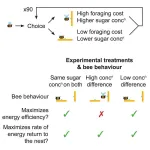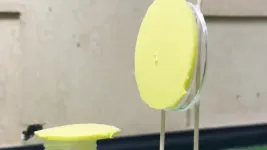(Press-News.org) An artificial intelligence tool effectively detected distress in hospital workers’ conversations with their therapists early in the pandemic, a new study shows, suggesting a potential new technology that screens for depression and anxiety.
As the coronavirus pandemic forced many hospitals to operate beyond capacity, medical workers faced overwhelming numbers of work shifts, limited rest, and increased risk of COVID-19 infection. At the same time, quarantine policies and fear of infecting family reduced their access to social support, with the combination increasing risk of medical errors and burnout.
As a result, virtual psychotherapy, which offers treatment access without leaving home, boomed during this period. The researchers took advantage of the related flood of digitalized session transcripts to identify common phrases used by patients and tie the terms to mental illness using a technique called natural language processing (NLP). In this method, a computer algorithm combs through data to pinpoint keywords that capture the meaning of a body of text. All identifying information about each patient was removed to protect their privacy.
Led by researchers at NYU Grossman School of Medicine, the analysis involved treatment transcripts from more than 800 physicians, nurses, and emergency medical staff. Also included were transcripts from 820 people also receiving psychotherapy during the first US wave of COVID-19 but not working in healthcare.
Study results revealed that among healthcare workers, those who spoke to their therapists specifically about working in a hospital unit, lack of sleep, or mood issues, were more likely to be diagnosed with anxiety and depression compared with healthcare workers who did not discuss these topics.
By contrast, such risks were not seen in workers from other fields who discussed the pandemic or their jobs (with terms such as “team,” “manager,” and “boss”).
“Our findings show that those working on the hospital floor during the most intense moment of the pandemic faced unique challenges on top of their regular job-related stressors which put them at high risk for serious mental health concerns,” said study lead author Matteo Malgaroli, PhD. Malgaroli is a research assistant professor in the Department of Psychiatry at NYU Langone Health.
Publishing online Oct. 24 in the Journal of Medical Internet Research AI, the report is the first application of NLP to identify markers of psychological distress in healthcare workers, according to Malgaroli.
For the study, the team collected data from men and women throughout the United States who sought teletherapy between March 2020 and July 2020. The researchers then used an NLP program to review session transcripts during the first three weeks of treatment.
Among the findings, healthcare workers shared four conversation themes around practicing medicine: virus-related fears, working on the hospital floor and ICU units, patients and masks, and healthcare roles. Meanwhile, therapy transcripts from those working in other fields only contained one topic about the pandemic and one related to their jobs.
Although the overall heightened risk for anxiety and depression among those who discussed working in a hospital was small (3.6%), the study authors say they expect the model to capture additional signs of distress as more data is added.
“These results suggest that natural language processing may one day become an effective screening tool for detecting and tracking anxiety and depression symptoms,” said study senior author psychiatrist Naomi Simon, MD, a professor in the Department of Psychiatry at NYU Langone.
Also a vice chair in the Department of Psychiatry at NYU Langone, Simon notes that another potential future direction for using this approach could be to provide healthcare workers a way to confidentially record themselves answering brief questions. These responses could then be analyzed using NLP algorithms to calculate risk for mental health conditions, such as depression or anxiety disorders. This feedback would then confidentially be provided to the healthcare worker using the tool, who might be prompted to seek help.
The researchers caution that the report only captured the mental state of patients early in their treatment. As a result, the team next plans to explore how the discussion topics change over time as therapy progresses.
Funding for the study was provided by National Institutes of Health grants KL2TR001446, R44MH124334, and R01MH125179. Further research support was provided by the American Foundation for Suicide Prevention, the U.S. Department of Defense, and the Patient-Centered Outcomes Research Institute. Talkspace, a mobile psychotherapy company, provided the data for the analysis but was not otherwise involved in the study.
Simon consults for biotechnology companies Axovant Sciences and Genomind, as well as for pharmaceutical companies Springworks Therapeutics, Praxis Therapeutics, and Aptinyx, and the information services company Wolters Kluwer. She also has spousal equity in G1 Therapeutics, which develops cancer treatments. The terms and conditions of these arrangements are being managed in accordance with the policies of NYU Langone.
In addition to Malgaroli and Simon, another NYU investigator involved in the study was Emma Jennings, BS. Other study investigators included Emily Tseng, MS; and Tanzeem Choudhury, PhD, at Cornell University in Ithaca, NY; and Thomas Hull, PhD, at Talkspace in New York City.
Media Inquiries:
Shira Polan
Phone: 212-404-4279
shira.polan@nyulangone.org
END
New tool may flag signs of pandemic-related anxiety and depression in healthcare workers
2023-10-24
ELSE PRESS RELEASES FROM THIS DATE:
Bumblebees visit flowers with more difficult-to-access nectar for immediate benefit to the colony
2023-10-24
If you’ve ever watched a bumblebee move from flower to flower, you might wonder how they decide which flower to choose and how long to stay. Now, researchers reporting in the journal iScience on October 24 have new insight based on their observations of bumblebees’ interactions with slippery artificial flowers. They found that the bumblebees make choices to maximize the rate of energy return, or the amount of sugar collected each minute.
“Bumblebees can make decisions ‘on the fly’ about which nectar sources are the most energetically economical,” said Jonathan ...
Making chemistry more accessible at the University of Oxford by providing period products
2023-10-24
When it comes to the question of who gets to be a scientist, gender disparities are well-documented in many fields. Patching the infamous “leaky pipeline” can be a thorny problem, but during the 2022–2023 school year, the Department of Chemistry at the University of Oxford took a simple and practical step forward: they began offering period products in the department’s bathrooms. In an article publishing October 25 in the journal Trends in Chemistry, three students involved in the Oxford Period Project and their supervising ...
Traditional chinese medicine compound (tongxinluo) and clinical outcomes of patients with acute myocardial infarction
2023-10-24
About The Study: In this randomized clinical trial of 3,777 patients with ST-segment elevation myocardial infarction (STEMI; a type of heart attack), the Chinese patent medicine Tongxinluo, as an adjunctive therapy in addition to STEMI guideline-directed treatments, significantly improved both 30-day and 1-year clinical outcomes. Further research is needed to determine the mechanism of action of Tongxinluo in STEMI.
Authors: Yuejin Yang, M.D., Ph.D., and Runlin Gao, M.D., of the Chinese Academy of Medical ...
Getting maximum calories in shortest time is the priority for bumblebees
2023-10-24
Research has found that bumblebees make foraging choices to collect the most sugar from flowers in the shortest time – even if that means using more energy in the process – to provide an immediate energy boost for the colony.
A new study investigating nectar drinking in one of the most common bumblebees in the UK, Bombus terrestris, has found that when foraging they maximise the amount of nectar sugar they take back to the colony each minute.
To make their choices, the bumblebees trade off the time they spend collecting nectar with the energy content of that nectar. This means ...
Incidence and transmission of SARS-CoV-2 in child care centers after COVID-19 vaccines
2023-10-24
About The Study: In this examination of SARS-CoV-2 incidence and transmission in child care centers (CCCs) and students’ households, transmission within CCCs and from children infected at CCCs into households was low in this study that included 83 children in 11 CCCs. These findings suggest that current testing and exclusion recommendations for SARS-CoV-2 in CCCs should be aligned with those for other respiratory viruses with similar morbidity and greater transmission to households.
Authors: Timothy R. Shope, ...
Neurodevelopmental outcomes among offspring exposed to corticosteroid and B2-adrenergic agonists in utero
2023-10-24
About The Study: The results of this study of 91,460 mother-offspring pairs found no association between in utero corticosteroid and β2-adrenergic agonist exposure and offspring neurodevelopmental outcomes, regardless of the timing of exposure. Despite the limitations and low power of the study, the findings suggest that corticosteroids and β2-adrenergic agonists are safe for pregnant individuals with asthma and the neurodevelopment of their offspring.
Authors: Abir Nagata, Ph.D., of Osaka University in Osaka, Japan, and Toshio Masumoto, Ph.D., of Tottori University ...
Child care centers unlikely source for COVID-19 transmission, study finds
2023-10-24
Children in child care centers are not spreading COVID-19 at significant rates to caregivers or other children at the center, nor to their households, according to a study led by University of Pittsburgh School of Medicine and UPMC Children’s Hospital of Pittsburgh pediatrician-scientists and published today in JAMA Network Open.
The findings suggest that recommendations to test symptomatic children for SARS-CoV-2, the virus that causes COVID-19, and keep positive children home from child care for prolonged periods can be revised to align with those for other serious ...
Pew funds 6 teams to advance cutting-edge biomedical research
2023-10-24
PHILADELPHIA—The Pew Charitable Trusts announced today the six pairs of researchers who will make up its 2023 class of Innovation Fund investigators.
These 12 acclaimed scientists—all alumni or advisors of Pew’s biomedical programs in the United States and Latin America—will partner on interdisciplinary research projects exploring key questions in human biology and disease. Combining the researchers’ expertise in topics ranging from neuroscience and immunology to cancer biology, these collaborations will help boost scientific discovery and improve human health.
“An interdisciplinary approach to research is critical to uncovering scientific breakthroughs ...
Givers to crowdfunding campaigns enjoy vicarious success
2023-10-24
Why would someone decide to give their money to help a stranger bring a creative project to life?
Recent research has found that backers of crowdfunding projects participate, in part, because of a sense of indirect success and the feeling that they are contributing to something bigger.
Crowdfunding — raising money for a new venture by collecting small amounts from many people — is most often done online, and messaging on the most popular sites reinforces the perception of a more democratic market.
But the reality is a bit ...
Climate report: ‘Uncharted territory’ imperils life on Earth
2023-10-24
CORVALLIS, Ore. – An international coalition of climate scientists says in a paper published today that the Earth’s vital signs have worsened beyond anything humans have yet seen, to the point that life on the planet is imperiled.
William Ripple, a distinguished professor in the Oregon State University College of Forestry, and former OSU postdoctoral researcher Christopher Wolf are the lead authors of the report, and 10 other U.S. and global scientists are co-authors.
“Without actions ...





